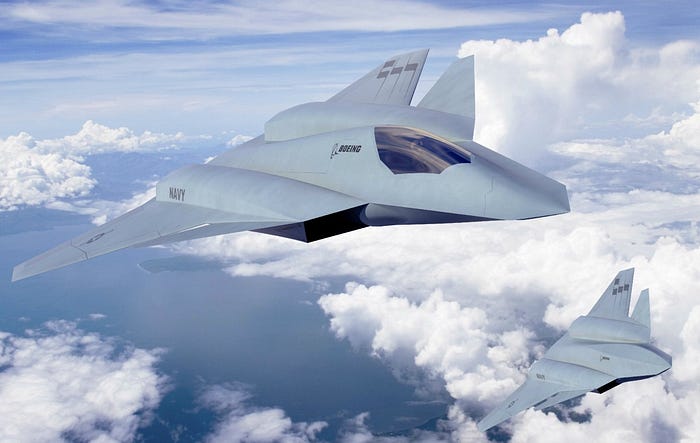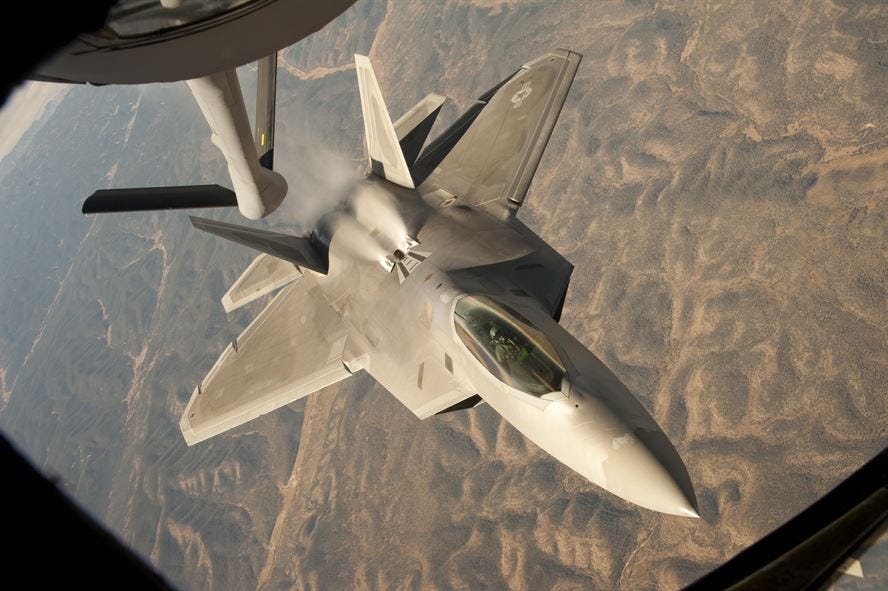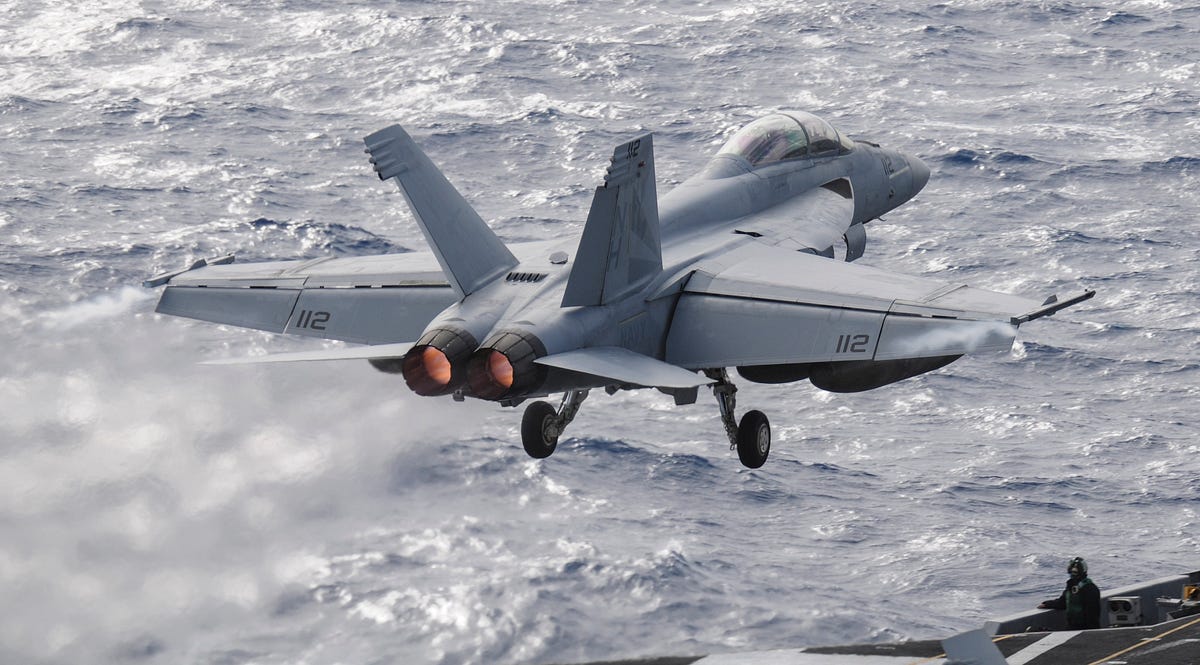
Boeing’s concept for an F/A-XX sixth-generation fighter might look like. Boeing art
No, we’re not sure yet what it will look like
America’s
next jet fighter—a so-called “sixth-generation” warplane— could be
fundamentally different than the current fifth-generation F-22 and F-35.
But it’s not clear yet what exactly that means.
In fact, terms like “fighter” or “bomber” might be holding the Pentagon back from taking full advantage of new technology.
“The
technology has taken us to a point that has exceeded the vocabulary and
semantics that have described aircraft in the past,” says David
Deptula, a retired U.S. Air Force intelligence chief and former F-15
pilot. “When you move to sixth-generation, it is going to be even more
different than the significant changes and advances in the technology
that has given us the capabilities resident in the F-22 and F-35.”
Although
the F-22 remains the world’s best air-to-air fighter, it’s now more
than 10 years old—the first operational examples having been delivered
to the Air Force in 2003. Given the time it takes to develop a modern
warplane, the Air Force must start thinking now about what comes next.
“[The
F-22] will be the preeminent airplane in the world into the 2030s,
until we come out with whatever the next platform or capability is,”
Gen. Mike Hostage, the head of Air Combat Command, said at the Air Force
Association conference in September.
What
technologies might be included in the new warplane is still an open
question. “It’ll be some type of game-changing capability,” Hostage said
earlier this year. “It’s not going to be an iterative growth of this
[current] capability.”
The Pentagon’s fringe-science
Defense Advanced Research Projects Agency has already started working on
that problem alongside the Air Force and Navy. The two services each
have their own sixth-generation fighter studies underway—the “F-X” and
“F/A-XX,” respectively.
The Navy project appears to be running somewhat ahead of the Air Force project because of the sailing branch’s need to replace its F/A-18E/Fs in the 2030s.
In any event, for the next decade or so the Pentagon will build the F-35—the F-22's newer, smaller and more compromised cousin—just to keep up numbers.
The
F-35 buys the military time to plan for a successor, says Rebecca Gant,
president of IRIS Independent Research and a paid consultant to the Air
Force, Navy and aerospace industry. “The next five years should be
devoted to maturing technologies: efficient, supersonic propulsion;
on-board lasers; masterful electronic warfare; longer-range missiles;
and other design and materials challenges, to include increasing
stealth.”

Term of art
If
future U.S. national security policy calls for operating over the vast
reaches of the Pacific, a future fighter aircraft might be fundamentally
different from anything that has come before. “We need to stop thinking
about combat aircraft as bombers and fighters or ISR [intelligence,
surveillance and reconnaissance] platforms for that matter,” says Mark
Gunzinger, an air power analyst at the Center for Strategic and
Budgetary Assessments.
Rather than simply basing a new
warplane on the latest technology, Gunzinger says the Pentagon needs to
first look at what it actually takes to win a likely war.
“Scoping the operational concept is, I think, going to be very important
to the kind of capabilities we want in the future.”
To
that end, the Pentagon needs to stop thinking in terms of simply
replacing existing fleets of jets, Deptula says. “We need to think less
about a one-on-one replacement of a particular type of aircraft and
think more about the effects that we want those aircraft to be able to
achieve,” Deptula says.
And whatever new plane the
Pentagon buys should be capable of doing lots of different things—not
just shooting down other fighters. “In the case of the F-X, F/A-XX, or
whatever designation you are using, what they are focusing on is the
need to achieve and maintain air dominance, and that’s fine, we will
need that capability,” Deptula says.
“But as we move
into an era of greater and greater accelerating technological
capability,” he adds, “I would suggest that we’re not going to build a
single-mission platform.”
Data-sharing will be vital,
Deptula argues. Advanced aircraft of the future could be “critical
nodes” of a much larger “combat cloud” architecture that further blurs
traditional divisions within air power. He says diverse missions such as
air-to-air combat, bombing and reconnaissance should be “integrated
into a single platform,” something that today’s warplanes already do, to
an extent.
In the future the U.S. might be fighting
enemies who are very different from those the nation has fought in the
past. America could find itself at war with a high-tech foe instead of
just another failed state or terror group.
A
full-scale technological conflict could prohibit U.S. aircraft from
using large, fixed bases near the front lines, as these facilities could
be vulnerable to enemy attack. Instead, warplanes would fly into battle
from far away, carrying with them all the fuel and weapons they might
need for a sustained fight.
“You might begin to
conclude that we might want a future air-superiority platform that has
more range than we typically think a fighter has,” Gunzinger says.
“Maybe a lot more range. And, frankly, we might want something that carries a great deal more payload.”
As such, the “the next-generation fighter might look more like a bomber,” Gunzinger points out.

Need for speed
But a sixth-gen warplane probably will not look like the Air Force’s new Long Range Strike-Bomber, Deptula says. The bomber is likely to be long-legged but slow. By contrast, a new fighter will still need to be fast in order to do battle air-to-air.
“Speed is going to be a critical piece,”
Deptula insists. Not coincidentally, the U.S. aerospace industry is
working hard on advanced new engines that could operate efficiently at
subsonic and supersonic speeds.
Meanwhile
stealth is not going anywhere—advanced low observables are going to be
as important as ever, Deptula says. But he grants that the ability to
avoid detection by radar is no “silver bullet,” as Air Force leaders
have sometimes portrayed it in the past.
Deptula
points out that there are likely to be lots of different types of radars
on a future battlefield. Even if a warplane’s shaping is less effective
in avoiding a particular radar band, that jet’s stealth could still be
useful against other frequencies.
Evading detection
“still is today, and will continue to be in the future, a critical
element—perhaps the most dominant element—in determining the
survivability of future aircraft,” Deptula says.
The
Pentagon is likely to want a new fighter with wide-band stealth
effective against the latest crop of low-frequency radars, which are
better able to detect current stealth jets, including the F-22 and F-35.
“I’m talking about something that is highly survivable,” Gunzinger says
of a sixth-gen plane.
Directed-energy weapons—that
is, lasers and microwaves—might also add an entirely new dimension to
air combat 25 years to 30 years in the future, Grant, Deptula and
Gunzinger agree. “Aerial combat might have a directed-energy dimension
to it that could really change the nature of how we do it and what we
need,” Gunzinger says.
If, for example, a new fighter
had a high-power laser able to destroy targets from far away, that could
completely negate the need for close-in maneuvering. “It could be a
complete game-changer,” Gunzinger says.
All this said,
it’s probably too early to start spending money on an actual
sixth-generation fighter program, Gunzinger adds. “I do think
it’s a worthy endeavor to think about the kind of characteristics you
might need in the future for an air-dominance platform.”
Because aerial warfare isn’t likely to go away.
No comments:
Post a Comment